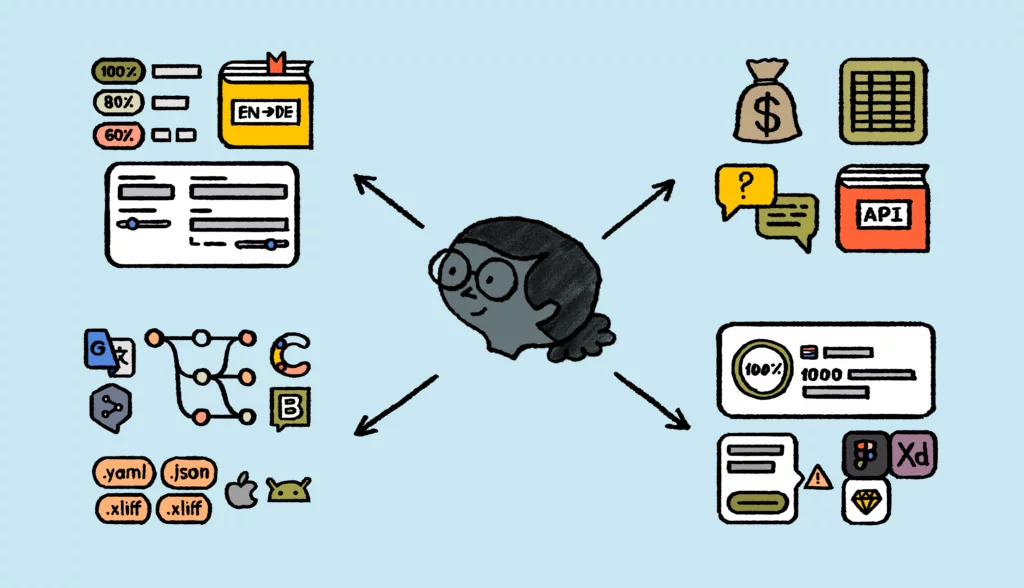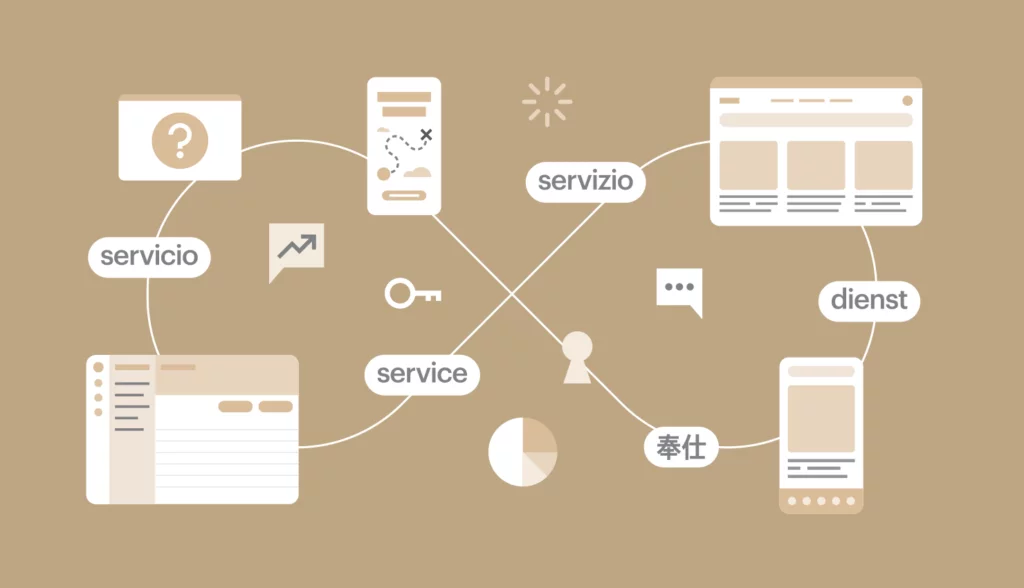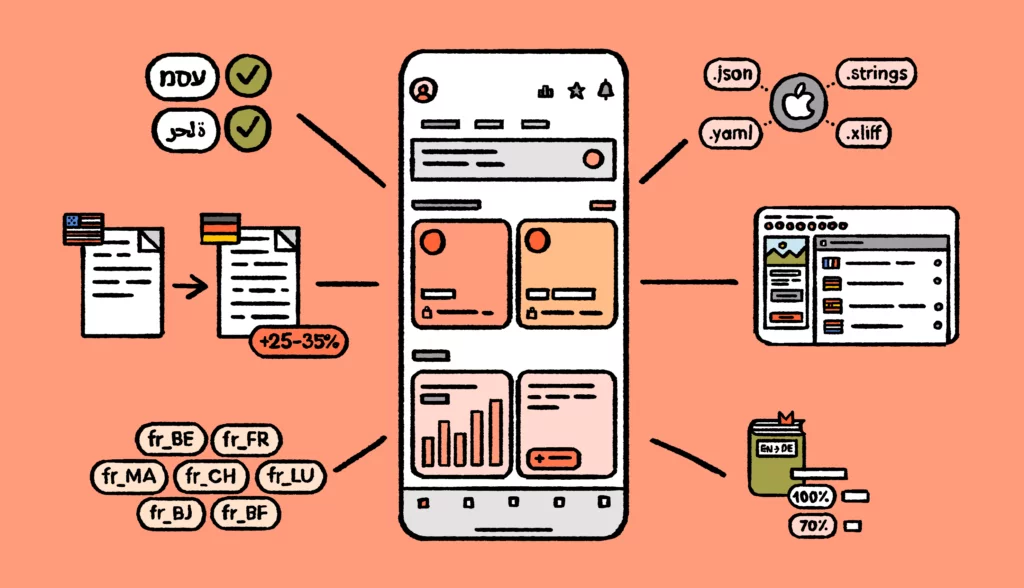When you’re expanding into new markets, your content needs to speak multiple languages.
But managing translations manually can quickly turn into a logistical nightmare.
This is where a Translation Management System (TMS) comes in.
In this comprehensive guide, you’ll learn everything you need to know about translation management systems, starting with understanding what is translation and how it plays a crucial role in the localization process.
💪Zero-fluff content
We consulted subject-matter experts, prepared simple examples and actionable tips, and created a simple framework that you can use to evaluate and choose a translation management system. You’ll also discover the quantifiable business benefits of centralizing your translation and localization workflows.
What is a translation management system?
A translation management system (TMS) is a software that centralizes your translation efforts, automates repetitive tasks, and helps you and your team stay organized.
Instead of juggling spreadsheets and translation files, you have an intuitive platform that scales with your needs.
Whether you’re translating into two languages or twenty, a TMS can save you time, streamline your workflows, and help you get your message gets across, no matter the market, language, or culture. Maintaining consistency and quality across languages gets a lot easier.
💡Choose the best TMS tool: Check out our guide on the best translation management systems to find the right platform for your needs.
What are the components of a translation management system?
Translation management software generally includes three main components to help streamline the translation process:
- Computer-assisted translation tools (CAT): These tools help translators work more efficiently by providing features like translation memory, glossaries, and machine translation suggestions
- Integrations and workflow automation: TMS helps you automate repetitive tasks and integrates with other tools, ensuring seamless content updates and efficient handling of large volumes of text
- Project/team management and reporting: Different tracking, reporting, and collaboration features support effective translation project management by allowing teams to manage translation projects, monitor progress, and keep up with the deadlines.
Together, these components support efficient workflow management, helping you scale your translation efforts. The inclusion of a translation glossary ensures consistency in terminology across all translated content, enhancing the overall quality and clarity of your communications.
📚 Further reading: Check out our guide on the best translation software and our analysis of 21 best workflow automation software.
What are the benefits of a translation management system?
We often ask localization project managers about their biggest challenges. Efficiently communicating with stakeholders, making sure the project timeline gets respected, and controlling the budget are the most common ones.
In the table below, you can see how having a TMS helps.
| Problem | Before TMS | After TMS |
| Scattered communication | Teams rely on emails, spreadsheets, and different platforms to manage translations, leading to miscommunication and confusion | All communication is centralized within the TMS, allowing teams to easily track and visualize every step of the localization process in one place |
| Translation inconsistencies | Without a single source of truth, it’s difficult to ensure the same tone, terminology, and style are used across different languages and regions | Teams work together within a single platform, ensuring content is consistent; translation memory and glossaries help maintain consistency across projects |
| Wasting time with manual tasks | Project managers waste a lot of time manually assigning tasks, tracking updates, and chasing down translators | Routine asks get automated; project managers can focus on higher-level responsibilities rather than manually overseeing each translation step |
| Missed deadlines | Without automated workflows, it’s easy to lose track of project timelines; this causes delays and inconsistency in localized content delivery | Automated workflows and progress tracking help keep projects on schedule, ensuring you meet deadlines and deliver a consistent, localized experience to every market |
Are there quantifiable business benefits to using a translation management system?
There are several quantifiable business benefits to using a translation management system (TMS). These measurable outcomes can help you justify the investment to decision-makers.
Save time and increase productivity
Translation memories, glossaries, and automated workflows can help boost translator productivity by up to 30% on average. Discover how Revolut saves 100+ hours a week by using a TMS.
Accelerate time to market
Automating workflows and streamlining collaboration can reduce project timelines by up to 40%, helping businesses launch in new markets faster. See how Elli, a brand of the Volkswagen group, ships new features in 23 languages every week thanks to their translation management system.
Reduce translation costs
A TMS typically uses translation memory to store previously translated content, allowing for reuse in future projects. This can reduce translation costs by up to 30-50%, especially for companies with recurring content (e.g., product updates or manuals).
💫 Get inspired
With a great TMS and a smooth process, translation costs can be reduced even more. See how Life360 translated their entire app in 5 languages in under a month, while saving 80% on translation costs.
Increase operational efficiency
A translation management system helps you scale translations without needing to drastically increase the number of project managers. Companies can manage larger translation projects with fewer resources, increasing operational efficiency by 20-40% on average.
Here’s what Sylvia Taube, Senior Product Manager at Indeavor, had to share about her experience using Lokalise as a TMS:
“Managing localization tasks now takes up about 1–5% of my work hours, while previously they occupied significantly more than that.”
In addition to freeing up manager’s time, Lokalise helped Indeavor’s development team spend 80–90% less time on adding new translation keys.
Improve accuracy and consistency
Consistency across all translated materials gets easier thanks to glossaries and translation memory. Using a TMS can cut down on revision cycles by 15-25% on average. You can expect to improve translation quality, and save both time and money on corrections.
💪Ensuring translation consistency for 900K+ app users
Discover how Rydoo improved translation consistency using glossaries and translation history within their TMS and achieved average app adoption rate of 93% within their first month.
How to choose a translation management system?
When choosing a Translation Management System (TMS), there are two main categories to consider: technical and business. Among the business-related factors, it’s also important to evaluate how the platform supports translation testing to ensure quality and consistency.
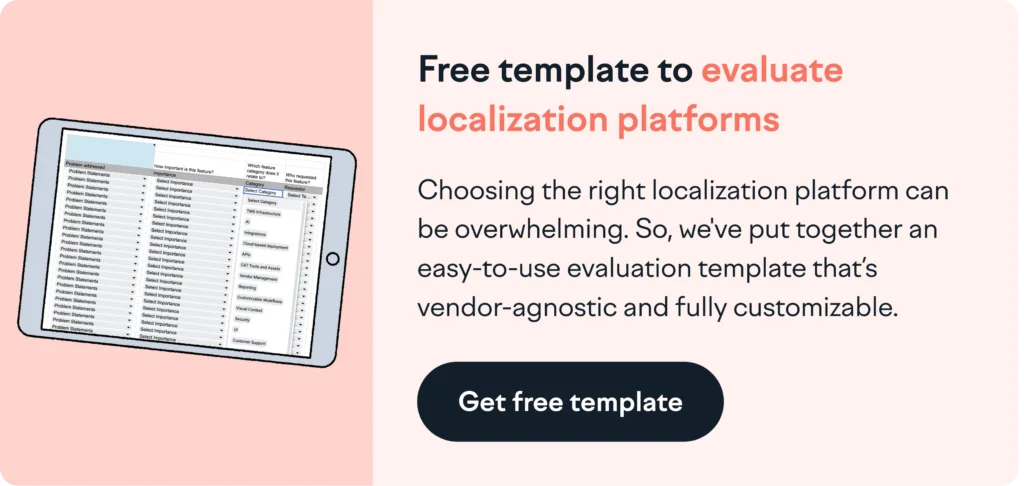
Key business factors when selecting a translation management system
1. The impact TMS will have on localization stakeholders
Implementing new processes can be challenging, and your team might resist change at first. However, in the long run, adopting a translation management system (TMS) can significantly boost productivity, improve collaboration, and speed up time to market.
To achieve these results, it’s crucial to choose the right TMS for your team. This means you need to think about everyone involved in the localization process.
Key stakeholders in localization
Localization workflows are rarely a one-size-fits-all approach, but there are four main groups of stakeholders involved in almost every localization team:
- Software developers and designers: Tech teams are natural partners in localization efforts, as they think in terms of systems and scalability. This is great news for people working in localization.
- Product and project managers: As a product or project manager, your focus should be on product development, improving localization quality assurance, and bringing localized products to market faster—not on manual tasks or maintaining inefficient systems.
- Copywriters, marketers, and translators: Marketing teams need smooth cross-team collaboration with minimal downtime, quick translation turnaround to meet launch deadlines, and scalability without compromising quality.
- QA specialists and reviewers: In addition to a solid localization kit (style guide, standards, etc.), QA teams need a system that ensures clear, streamlined processes, aligning different teams in the correct sequence.
Taking the time to understand your team’s needs will help minimize resistance, gain their support, and implement a solution that benefits everyone.
📚Further read
Learn how to build a strong localization team from 10+ companies, including ActiveCampaign and Onfido.
2. Aligning your translation management system (TMS) with business goals
Every TMS has its own set of features and is designed for a specific purpose. For example, Lokalise is built for agile teams that want to seamlessly integrate localization into their continuous product development workflow.
It’s very important to align the choice of TMS with your business goals and the product you are localizing. Ask yourself:
- Does this TMS enable us to improve translation quality?
- Is it helping us accelerate product release cycles?
- Can we automate some parts of the translation process?
- Will it help us increase productivity?
- Will we be able to reduce our localization costs?
3. The impact TMS will have on speed of delivery
Working in localization, you may have experienced the frustration of not being able to match localization with the pace of agile development.
In the words of one localization manager, the goal is never just to localize. The goal should be to impact a specific business metric. So, what are the best localization metrics?
- Budget
- Project KPIs (e.g., number of keys/words)
- Time to market
- Localization ROI
While ROI consists of hard-to-quantify factors, the TMS you choose should have built-in analytics and reporting, allowing you to stay on top of performance and see the direct impact of localization efforts.
Here’s what the project dashboard looks like in Lokalise:
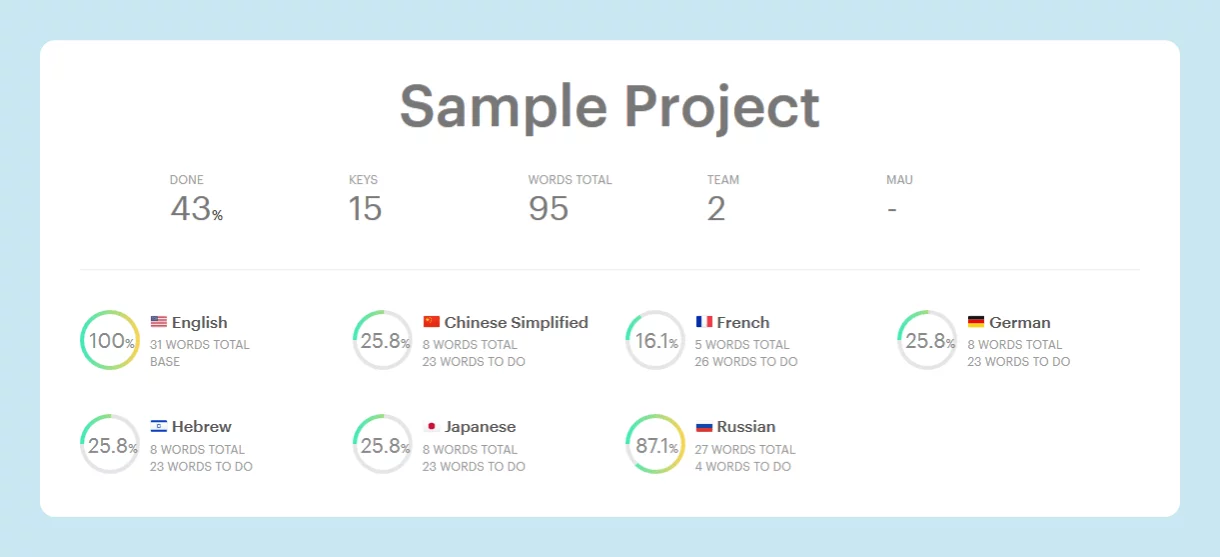
If your goal is speed, you should be able to see a significant impact on time to market after implementing the TMS.
For example, a product manager at Withings, championed a new localization flow and increased localized feature rollout by 90%.
4. Improving translation quality and content for end users
A translation management system (TMS) improves translation quality by keeping content consistent across all languages. With tools like translation memory and glossaries, you can make sure you use the same terminology and tone across different languages. This makes your content clearer and more relatable to your audience.
With fewer manual steps, the system helps reduce errors, so translations are more accurate. On top of that, a TMS speeds up content updates, so your users get fresh, relevant information quickly.
To make quality assurance easier, your TMS needs to have:
- Built-in QA checks
- Features that ensure visual context
- Integrations with the design tools you already use (e.g., Figma, Sketch, Adobe XD).
These are some of the key features that will help you build a design-led localization workflow and perform pre-production QA. Plus, your linguists will be able to move faster with visual context.
5. Deciding on the budget
Budgetary conversations are often what bring about friction regarding localization. Stakeholders are sometimes shocked by translation rates because they lack a clear understanding of what influences them.
Budget conversations can create friction around localization because stakeholders are sometimes surprised by the costs. It’s because they don’t fully understand the complexity involved.
If your current localization process isn’t scalable or automation-friendly, it will likely lead to higher costs and longer delivery times.
💡Pro tip
Investment is not the same as an expense. You need to differentiate between “good” costs—those that drive business results—and “bad” costs that can be reduced or eliminated. For instance, stopping a developer to fix a bug or reworking a design because the translated text doesn’t fit costs you time and money. In short, more manual steps equal higher localization costs, so it’s important to plan for that upfront.
Key technical factors to consider when selecting a translation management system
When reviewing, evaluating, and selecting a your translation management system, you’ll need to focus on five key technical aspects.
Without addressing these fundamentals, streamlining your localization workflow, particularly as you add more languages, will be challenging.
Here’s what you need to take into account.
1. Identify content formats
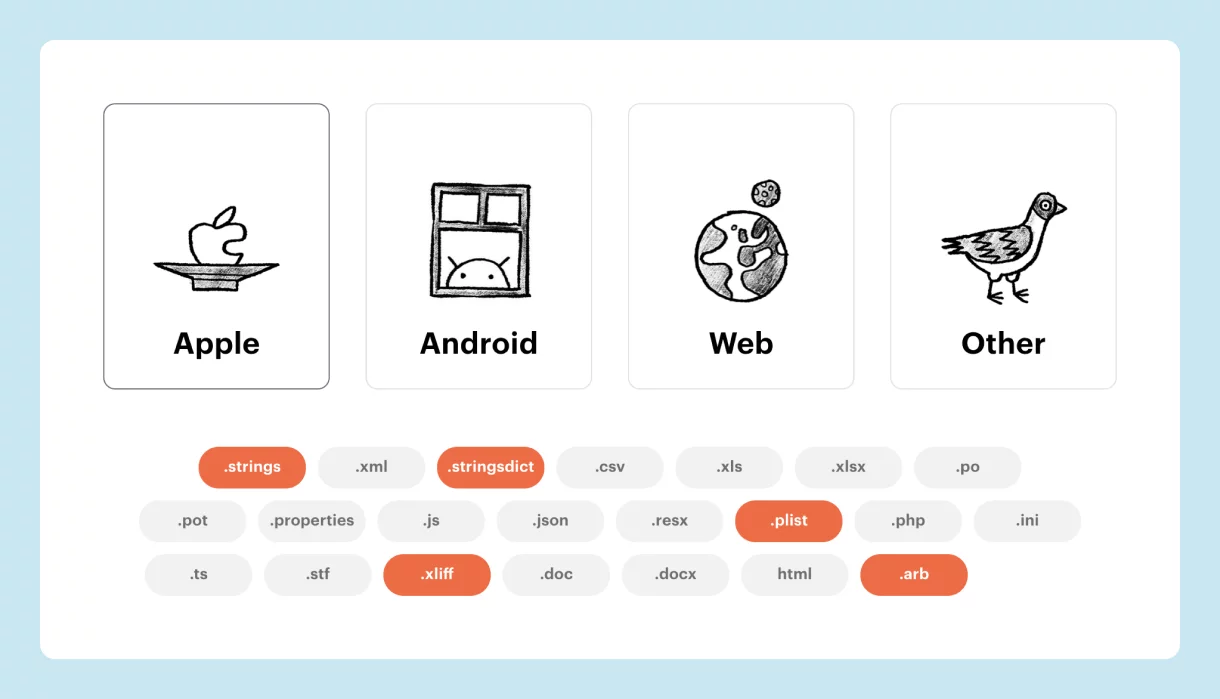
Content creation methods are often not scalable or flexible enough for global business demands.
Many companies overlook a key step for easier localization: storing strings in resource files instead of embedding them in the codebase. To streamline localization, developers need to externalize strings using formats like JSON, YAML, ARB, XLIFF, Android Resources, or Apple Strings.
At a minimum, your TMS should support various formats and sync with major code repositories. If you’re working with multiple file types and systems, make sure your TMS integrates smoothly with your workflow and tech stack. You’d want to avoid manual work as much as possible.
2. Determine where your content is created, stored, and published
Consider where your content is stored. Is there a single source of truth, or is it spread across multiple systems? Do those systems support import/export of different file formats?
A localization process owner must know the answers to these questions because content creation, storage, and publishing often involve different systems. Ideally, content should reside in a content management system (CMS) with APIs or connectors to the TMS.
However, the setup depends on the content type, its source, and how it’s published. Many companies manage content across multiple systems, but the TMS serves as the central hub where all multilingual content is stored and managed across the organization.
3. Take into account the frequency of content updates
Can’t you just update content once and be done? Probably not.
Before you choose your translation management system, consider how often your company’s digital or web content changes. Managing long-term content localization is extremely important. This is where systems, integrations, and update frequency come into play.
The right TMS will support a continuous localization workflow, ensuring updates happen smoothly over time.
4. Identify which processes can be automated
If you think about scalability in the context of localization, it’s clear that you want a replicable process that you can apply to all new languages. It shouldn’t be surprising that building an automated workflow is a key part of optimizing your localization process.
Since localization involves multiple teams, the more manual work required, the higher the costs. Here are some key areas where your TMS should help automate:
- Transfer of files between systems (e.g., two-way integrations that sync with code repositories, CMS, and design tools)
- Conversion of files to different formats
- Version control to quickly detect file updates
- Pre-translation using machine translation
- KPI tracking and report generation
This isn’t an exhaustive list, but your TMS should automate as much as possible to reduce manual work and optimize efficiency. See the video below to discover how Automations work in Lokalise.
5. Decide on the key features your TMS has to have
There are many translation management systems available, and while they offer similar features, they don’t all function the same way. It’s a good idea to test each TMS to ensure the features work as you expect.
Additionally, make sure the key features you need are included in the plan you can afford. Some important features may only be available in higher-tier plans, so it’s important to find a TMS that offers the best value for your money.
The main features a TMS should include:
- Single dashboard to view all your global content in one place
- Workflow and task management to keep teams and tasks on track
- Easy team collaboration so everyone is on the same page
- Professional translation services that you can order and manage directly from your TMS
- Translation memory for storing past translations that can be reused
- Translation glossary for keeping brand terminology and style consistent
- AI-powered quality assurance, combined with Linguistic Quality Assurance practices, ensures high-quality translations.
- Screenshots and in-context editor for translation with visual context
- Integrations with your tech stack, including repositories, content management systems, and design plugins
- Machine translation and custom AI-powered translation for faster translation turnarounds and lower costs
By setting up your TMS with the features mentioned above, your translation and localization process will run much more smoothly.
Every team member, from product managers and translators to developers and designers, will know their role and timeline, with less manual work involved. This will save you time and money, and you’ll be able to launch in global markets faster.
Is Lokalise the right translation management system for you?
Lokalise could be the right translation management system if you’re looking for seamless integrations, automation, and scalability. It helps you streamline the localization process while reducing manual tasks.
Our goal is to help you choose the right translation management system for your company. To evaluate if Lokalise might be it, we invite you to:
- Explore our case studies which feature companies from a range of industries and use cases, and see how they use Lokalise to drive growth
- Check out our TMS evaluation template – it’s free and fully customizable so you can make informed decisions when choosing a TMS
- Sign up for a 14-day free trial of Lokalise to see the tool in action (we don’t ask you for credit card info)
- Even better – book a demo with one of our product specialists and get a tailored consultation for your specific business case
Want more guidance? Our team is here to help. Feel free to drop us a line in our live chat (it’s in the lower right corner) and we’ll gladly lend you a hand.


